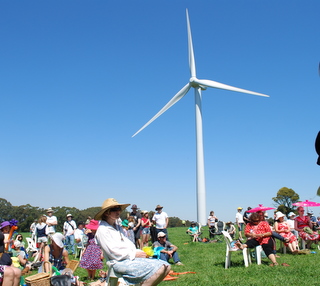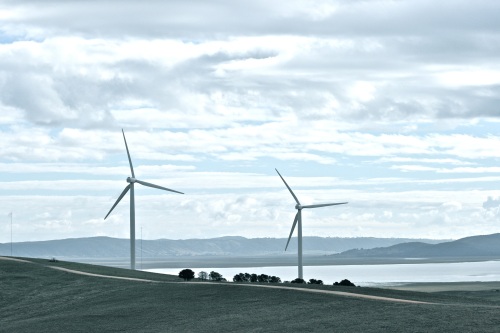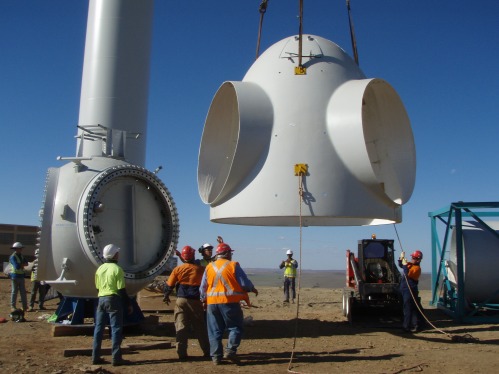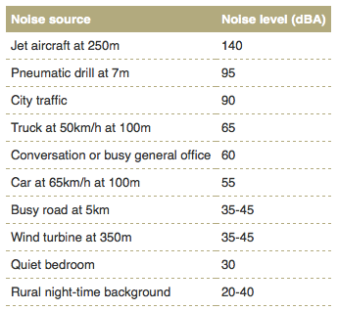Wind farms: Up for the job of powering the economy
- South Australia leads the nation on wind energy and renewables. Wind farms have overtaken coal power plants to provide 35 per cent of the state’s electricity needs.
- According to market operator AEMO, over 60 per cent of South Australia’s new electricity capacity will come from wind farms between now and 2020. Respected energy commentator Giles Parkinson says the South Australia “could be the first industrial economy to reach 50 per cent variable renewable generation.”[1]
- Research shows shifting to 100 per cent renewable energy is both technically viable and affordable. Studies by AEMO[2] and University of New South Wales[3] confirm the technical feasibility of renewable energy.
Wind energy: Australia’s cheapest electricity
- The Bureau of Resources and Energy Economics expects onshore wind farms to be the cheapest form of electricity by 2020.[4] Analysts at Bloomberg New Energy Finance say “Wind is now cheaper than fossil fuels in producing electricity in Australia.”[5]
- In terms of cost, AEMO conclude a 100 per cent renewable energy system is cheaper for Australians than fossil fuels and business-as-usual.[6]
Wind farms cut power bills
- Wind energy puts downward pressure on power bills. Energy analysts from the University of Melbourne identify wind farms as the driver of declining wholesale electricity prices in South Australia. The state has the lowest wholesale electricity prices since the National Energy Market commenced in 1998.[7]
- The SA Essential Services Commission directed energy companies to cut retails prices by 8.1 percent—passing on the savings from lower wholesale prices. The move will lower the average power bill by $160 a year.[8]
Wind farms have a clean bill of health
- More than 20 reviews have by credible health authorities show wind turbines are clean and safe.[9]
- Australia’s authority on public health research, the National Health and Medical Research Council (NHMRC), has said:[10]
…There is currently no published scientific evidence to positively link wind turbines with adverse health effects.
- A peer-reviewed study published in PLOS One journal found 99 percent of Victorians living within 5km of a wind farm do so without complaint.[11] Professor Simon Chapman and academic Fiona Crichton identify anti-wind fear mongering as the cause of ill health effects rather than turbines.[12]
Wind farms create jobs
- Research by Sinclair Knight Merz (SKM) shows a typical 50-megawatt wind farm creates 48 direct construction jobs and five on-going jobs for the life of the project (generally around 30 years). [13]
- Portland’s Keppel Prince Engineering employs 60 people in turbine tower fabrication. A thriving wind energy sector means more manufacturing jobs for southwest Victoria.
Wind farms generate income for the community
- Research by Sinclair Knight Merz (SKM) shows a typical 50-megawatt wind farm will generate $250,000 for wind farmers each year, and contribute up to $80,000 annually to community projects.
- Pacific Hydro is the single largest ratepayer to the Ararat Rural City Council from revenue generated by its Challicum Hills wind farm.
Wind farms are quiet
- Wind farms built in Australia must be built to meet strict noise regulations. Wind farms are substantially quieter than other sounds experienced in everyday life.[14]
Wind farms and real estate
- In 2009, the NSW Valuer General concluded wind farms do not negatively affect property values. No reductions in sale price were observed for rural properties located in nearby townships with views of wind farms.[15]
- In Waubra, the location of one of Australia’s largest wind farms, the real estate value of residential properties has increased 10 percent over the last two years.[16]
Wind farms cut emissions and climate change impact
- Data from AEMO’s South Australian Historical Market Informationreport shows greenhouse gas emissions from the power sector have declided by over 30 percent since 2005-2006. This corresponds with the growth of wind energy.[17]

Community members from Daylesford and Hepburn Springs love renewable energy so much they built their own wind farm.
Victorians support more wind energy
- A poll commissioned by Pacific Hydro in 2012 demonstrates 82 per cent of Victorians support more wind power in the state.[18]
- Polling by Essential Research conducted in June 2013 shows massive 71 per cent of Coalition voters supporting more wind farms.[19]
- In 2013, community members in central Victoria stood up against anti-wind farm activists in support of the Cherry Tree Range wind farm.[20]
References:
[1] http://reneweconomy.com.au/2013/south-australia-heads-to-50-renewables-within-a-decade-21296
[2] http://www.climatechange.gov.au/sites/climatechange/files/documents/08_2013/100-percent-renewables-study-modelling-outcomes-report.pdf
[3] http://www.ies.unsw.edu.au/sites/all/files/profile_file_attachments/LeastCostElectricityScenariosInPress2013.pdf
[4] http://reneweconomy.com.au/2012/canberra-concedes-wind-solar-to-be-cheapest-energy-by-2030-82930
[5] http://www.bloomberg.com/news/2013-02-06/australia-wind-energy-cheaper-than-coal-natural-gas-bnef-says.html
[6] http://reneweconomy.com.au/2013/energy-costs-business-as-usual-no-cheaper-than-100-renewables-39933
[7] http://reneweconomy.com.au/2013/electricity-prices-fall-renewable-energy-deserves-merit-79890
[8] https://theconversation.com/power-of-the-wind-how-renewables-are-lowering-sa-electricity-bills-9945
[9] http://tobacco.health.usyd.edu.au/assets/pdfs/WindHealthReviews.docx
[10] http://www.nhmrc.gov.au/_files_nhmrc/publications/attachments/new0048_public_statement_wind_turbines_and_health.pdf
[11] http://www.plosone.org/article/info%3Adoi%2F10.1371%2Fjournal.pone.0076584
[12] http://theconversation.edu.au/wind-turbine-syndrome-a-classic-communicated-disease-8318
[13] http://www.abc.net.au/site-archive/rural/news/content/201303/s3702991.htm
[14] http://www.embark.com.au/display/public/content/Wind+myths+and+facts#Windmythsandfacts-Noise
[15] http://www.lpi.nsw.gov.au/__data/assets/pdf_file/0018/117621/t0L51WT8.pdf
[16] http://www.pyrenees.vic.gov.au/Your_Council/Councillors/Council_Meetings/21082012
[17] http://www.businessspectator.com.au/article/2013/8/1/renewable-energy/sa-emissions-down-third-2005
[18] http://www.pacifichydro.com.au/files/2012/01/2012-Community-polling-base-results-by-State.pdf
[19] http://essentialvision.com.au/wind-farms
[20] https://yes2renewables.org/2013/11/28/local-group-welcomes-vcat-wind-farm-decision-2/





This is a really good reference for people concerned about wind energy and for dealing with those who insist on remaining ignorant of the facts. I hope a special copy is forwarded to Angus Taylor, Tony Abbott and Joe Hockey
This has nothing to do with wind power!
http://casualinfamy.com/behind-the-modern-green-facade/
TCW
You really need to grow up TCW, your Chicken Little act is getting pretty boring and repetitive. The fact that you provide no new, credible information to back up your opposition to wind energy shows you are driven by ignorance and denial rather than evidence. You really need to move on.
Reblogged this on greenstreampublishing and commented:
Good post on the basics of wind energy.
Well said Blair, agree with you. With the IPA’s Landscape Guardians, dominated by Dick Warburton, who is trying his hardest to destroy renewable energy, there needs to be a really concerted response by intelligent, well-informed, people who have great concern for our future with a healthy, bio-diverse, clean energy World.